We left our accommodation in Tavistock, a 600 year old converted priory called, The Priory B&B, early in the morning for the 45 kilometre journey which skirted Dartmoor National Park along the western edge.
We were fuelled on one of the best breakfasts we'd had, and excitement. We were off to Castle Drogo which lies just within the borders of Dartmoor National Park, at the northern edge near Exeter. We had a planned stop at Lydford to see the 1000+ year-old Norman castle ruins there and had a few hours set aside to tour around Castle Drogo, something I'll write about in another post.
It was a nice drive, mainly A-roads which are a little wider than the narrow country-lane B-roads, and our hire car was a pleasure to drive, comfortable, powerful and well-appointed. Of course, all I really needed was my shotgun-rider Faith, it doesn't matter what car I drive as long as she's with me.
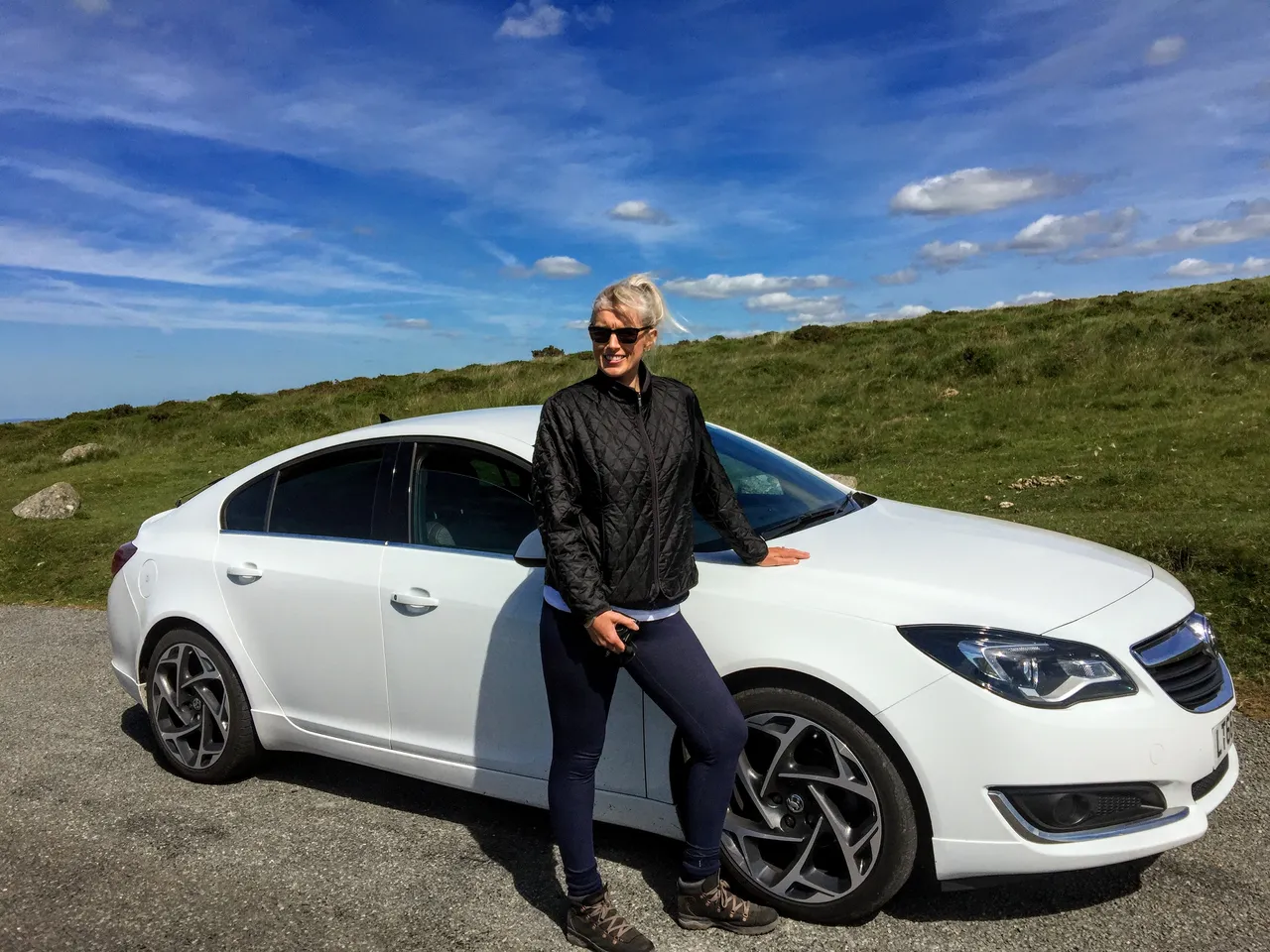
The moorlands of Dartmoor
From Drogo we were heading to Boscastle on the west coast but rather than take the A30 west, the fastest route, we decided to head south through Dartmoor National Park; It was a 90 kilometres route instead of 75 kilometres, and it went back through Tavistock, however would give us a chance to head through Dartmoor where we hoped we'd see some Dartmoor pony's along the way.
This post touches briefly on that journey through Dartmoor National Park, UK. I'm sorry the photos aren't great...I blame the camera (operator).
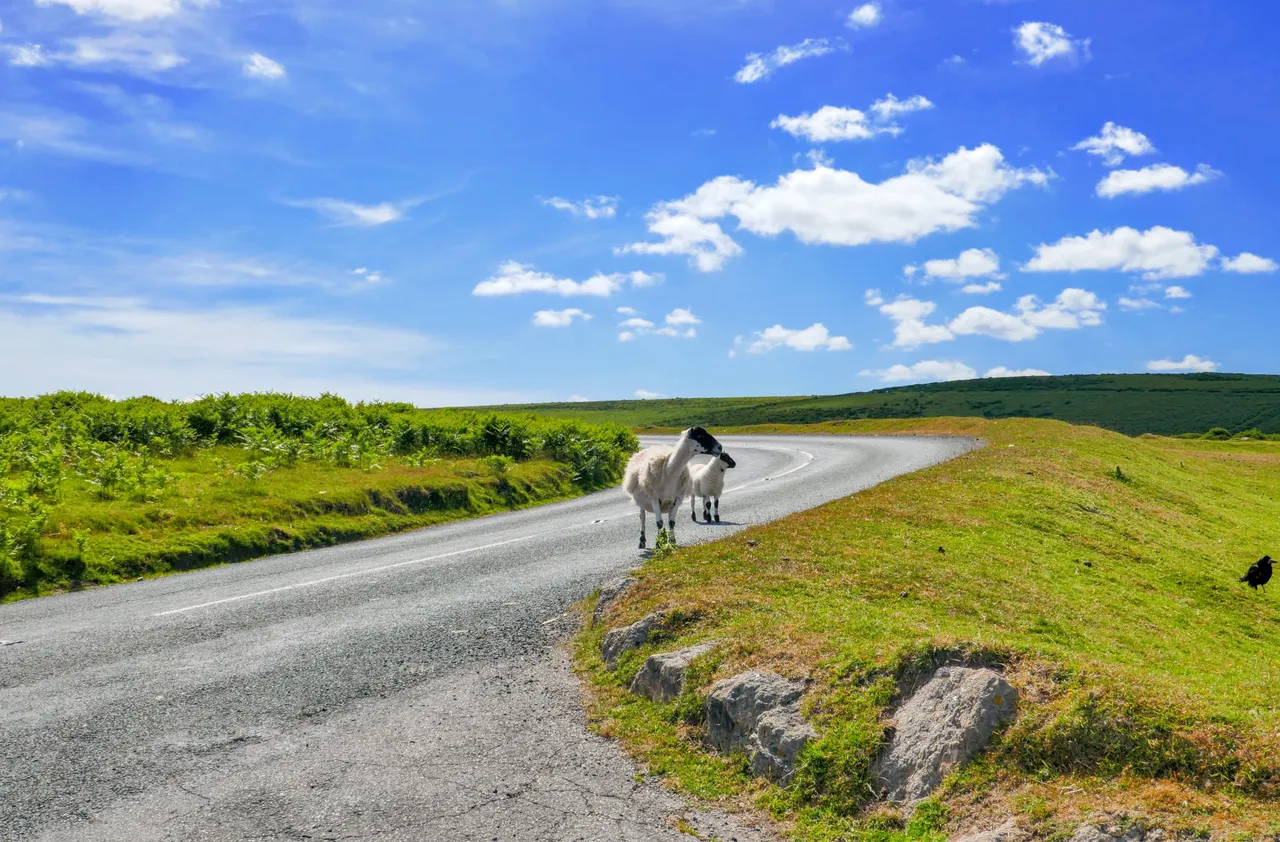
These two characters are not Dartmoor pony's...They're sheep, called Scotch blackface sheep, the most common found on Dartmoor.
There's other breeds of sheep there also and it is said that the native breeds actually descend from the Iron age 'soay sheep'. I think this is speculation more than fact though.
We pulled into a parking bay to take some shots of the screensaver vistas around us and the sheep were just wandering about, as sheep do, all over the road and in the fields. After a little while we saddled back up and headed further south.

Here's the view from the car park we stopped at. Those are not sheep in the foreground though, they're rocks and not as fun to pat.

Dartmoor National Park has a lot of different animals within it but perhaps the most notable is the Dartmoor Pony. Here you see Faith making friends with one that was impervious to her charms.
The pony's have inhabited Dartmoor for many thousands of years and over that time have been used for various purposes by humans. They are an extremely hardy animal, essential due to the extreme weather found in Dartmoor, and have been used as a working and pack animals in mines and quarries. They are also known to have a very nice temperament being gentle and calm of nature and very reliable.
Faith is the horse-whisperer of the family; If there is a horse within ten kilometres of her she knows and will find it, and they love her. She was very excited to see the Dartmoor Pony's and still remembers the experience fondly. It's kind of cute to see her around horses, she really loves them.
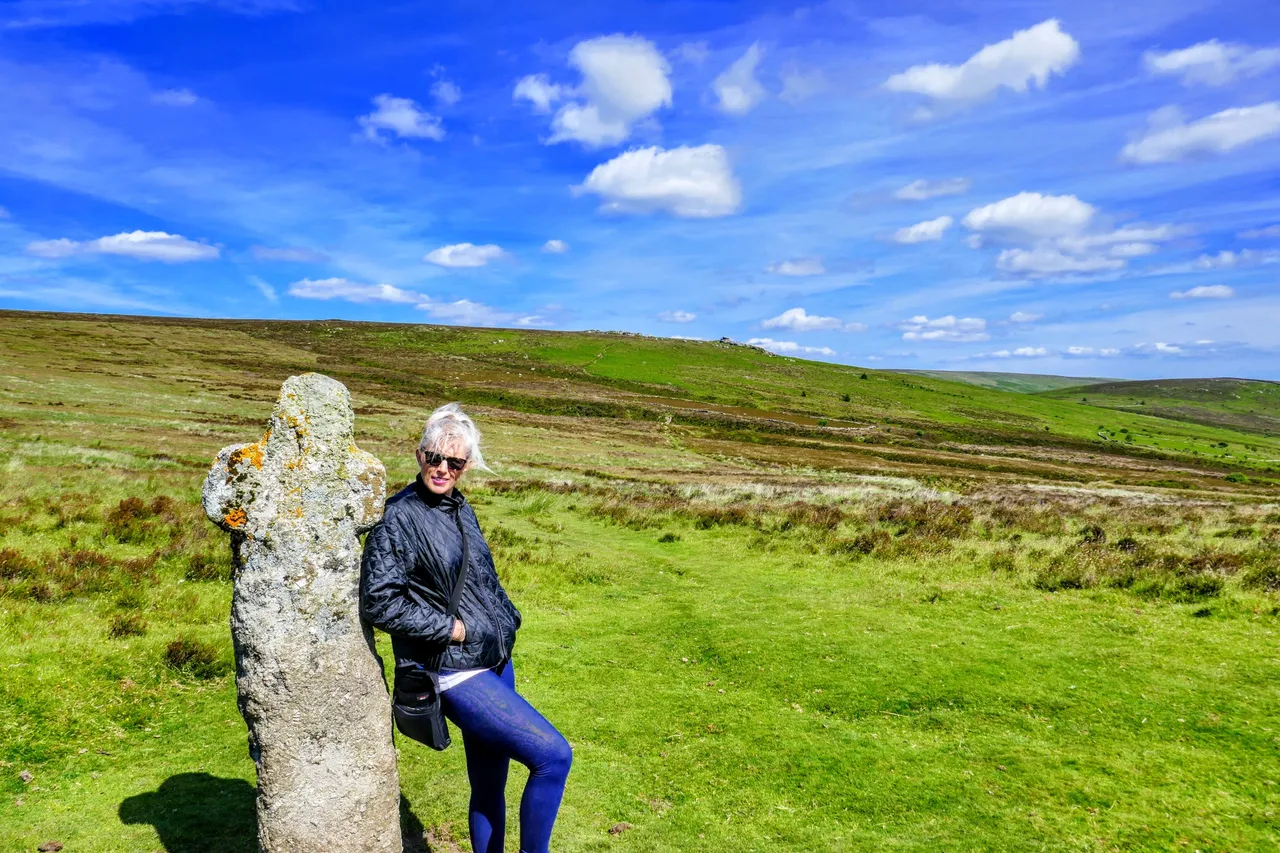
Faith leaning on a Dartmoor pony cross which are dotted across the moorlands.
These crosses were often placed as navigational aids; This was important due to the often poor weather conditions, low cloud, fog and rain that is prevalent on Dartmoor. Of course, there was no sigh of that the day we were there; Blue skies and cool...Just perfect.
These moorland way markers often marked medieval routes from abbey to abbey and some are simply memorials and boundary markers. Most are very old, like the one Faith is leaning on above, some 1000 years old, and others are only hundreds of years old. You can also see a tor in the distance to the right of the hill.
A tor is a rocky outcrop which rises abruptly from the surrounding smooth, gentle slopes of a rounded hill, ridge-crest or summit. Essentially, a pile of rocks.
Here in Dartmoor the granite deposited 280 million years ago was exposed through erosion and then exposed to chemical and weathering processes. That allowed the large crystals found in the granite to disintegrate leaving what looks like a stack of rocks placed one on top of the other. This takes millions of years of course.
We would have liked to do some hiking in the moorlands and visit some of the tors up close although time wasn't on our side on this trip.
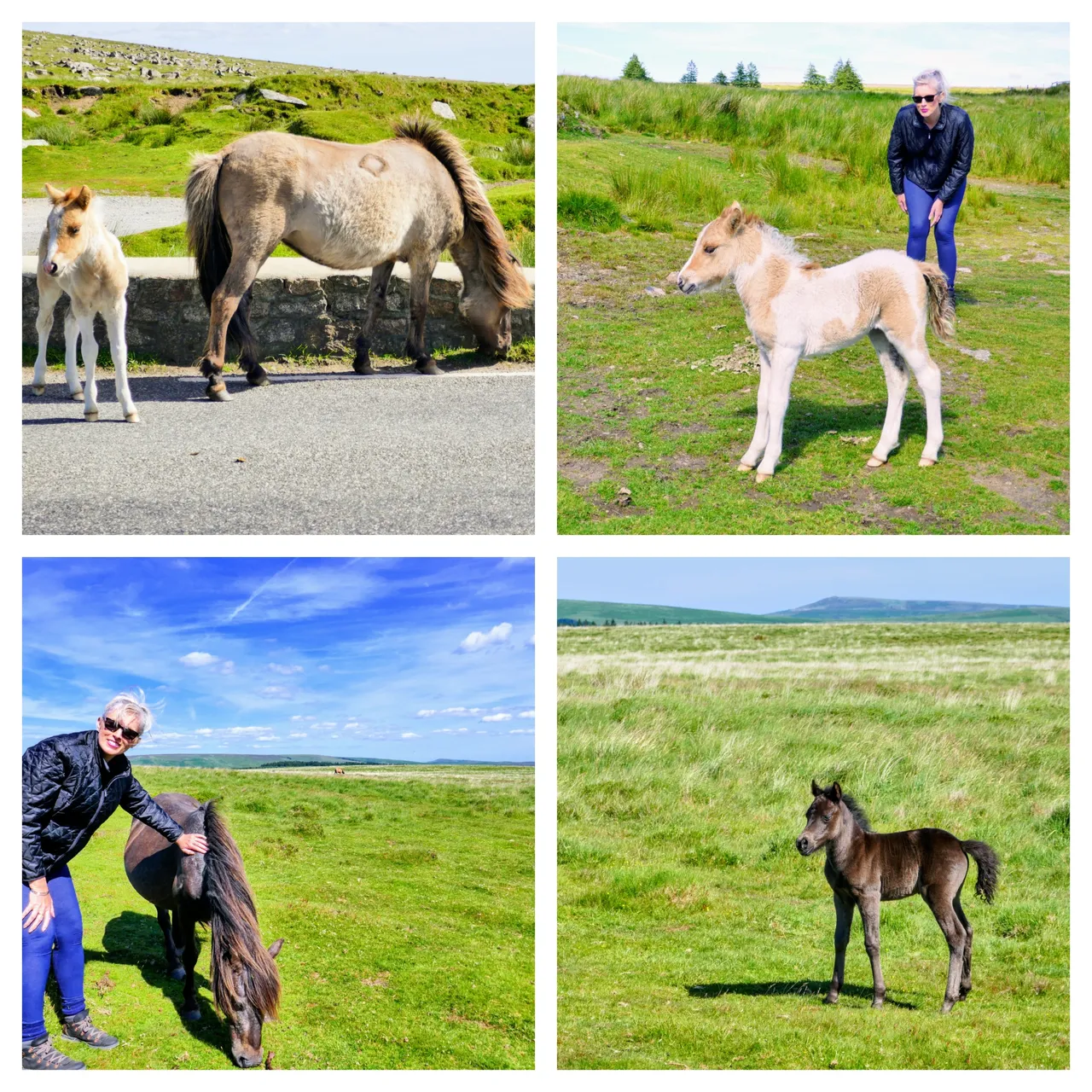
Top right, Faith stalking a poor unsuspecting little foal.It's ok to pat them but visitors feeding them is against the law.
The Dartmoor pony's roam free on the moorlands and one must be cautious when driving as they are often found on the roads. We stopped many times so Faith could say hello and have a pat and especially when there were little foals wandering about. Above you can see some, and Faith stalking one. They weren't as trusting as the adults but sure were cute.
Dartmoor pony's are in decline and only hundreds remain where once there were some 5,000 of them. That decline has occurred over only about 120 years and is quite sad. We felt quite privileged to have an experience with them in the place of their origin and whilst they can be found elsewhere, even in Australia, to see them here in Dartmoor where they have been for many thousands of years was pretty special.
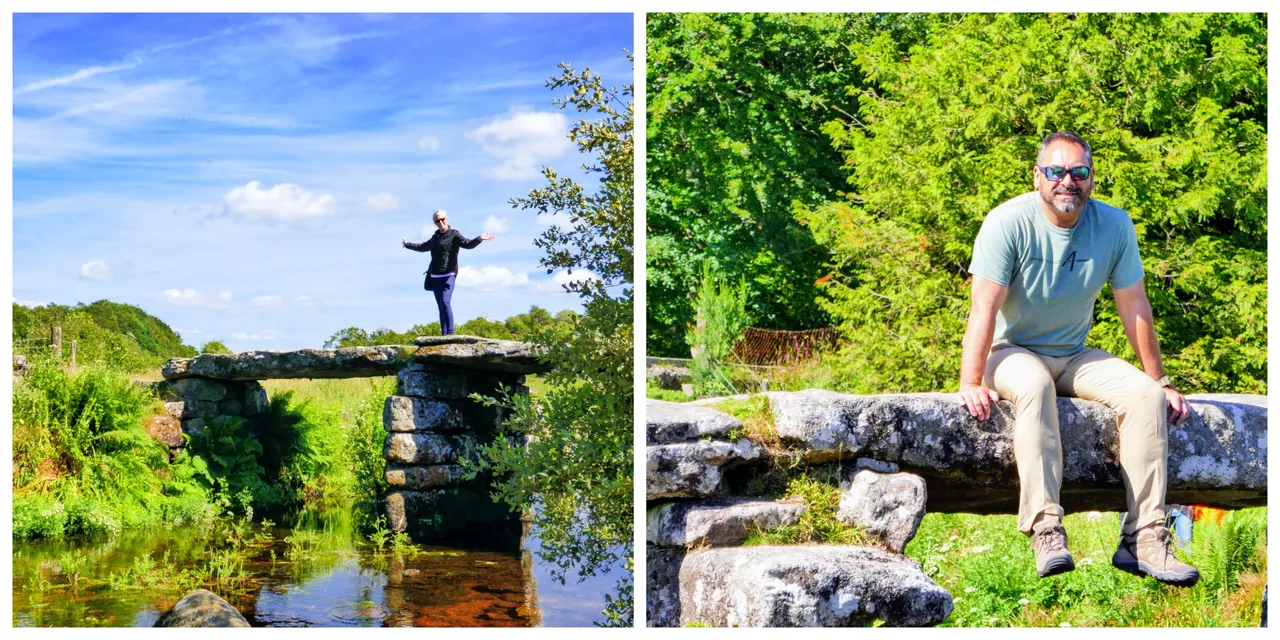
The clapper bridge of over 700 years in age, located at Postbridge.
Right in the centre of Dartmoor is a pretty cool little feature called a clapper bridge right near a little blink-and-you-miss-it place called Postbridge. A clapper bridge is a made by placing huge flat stones like granite on top of stone piers and are used to bridge rivers, streams and creeks. Sometimes they are simply a single massive stone spanning bank to bank and sometimes they are quite long constructions.
The bridge at Postbridge is suspected to be some 700 years old and is constructed of slabs of granite over four metres long, or 13 feet in the old measurement. They are about two metres wide, so there's ample room for small carts to cross. This bridge was used to transport tin from Dartmoor to Tavistock by pack horse, the Dartmoor pony of course. Each of the stones on this bridge weigh eight tons, all moved by hand. It was cool to wander about and think about all the things this bridge has seen in its history.
From Postbridge we headed south to Two Bridges, not a town, just a pub really, and then west to Tavistock and finally Boscastle on the west coast.
As I said above, we would have loved to have spent more time in Dartmoor, hiking and camping overnight, however it wasn't possible. We had a nice few hours though and enjoyed every moment.
The roads, whilst quite narrow B-roads, are in good condition and we were in no hurry to get through; We just took our time, pulled over a lot, and soaked it all in. Will we ever get back for that hiking? I'd like to think we will.
Design and create your ideal life, don't live it by default - Tomorrow isn't promised.
Be well
Discord: galenkp#9209